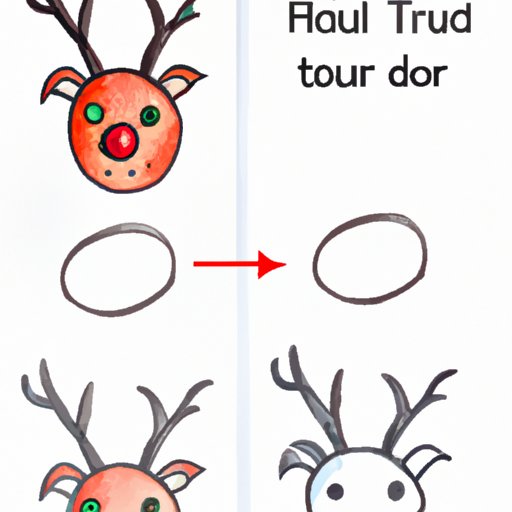
I. Introduction
With the holiday season in full swing, one of the most beloved characters we cannot ignore is Rudolph the Red-Nosed Reindeer. Rudolph has been a staple of holiday folklore since 1939, and it’s hard to imagine Christmas without him. In this article, we will show you how to bring Rudolph to life right on your paper!
II. Step-by-Step Tutorial on Drawing Rudolph
Drawing Rudolph doesn’t have to be complicated. By following these steps, you’ll be able to draw your own Rudolph in no time!
A. Starting with basic shapes and lines
Begin by drawing a circle for the head and a larger circle for the body. Follow this by drawing two lines connecting the body to the head, which will be the neck. Use another circle for the snout and two diagonal lines for the cheeks.
B. Adding details such as antlers and unique facial features
Next, draw the antlers – consider antlers as branches of a tree. Add the eyes, eyebrows, and mouth following the diagonal lines made earlier and adding eyelashes for added effect.
C. Adding Rudolph’s signature red nose
Rudolph wouldn’t be Rudolph without his red nose, so draw a circle in the center of Rudolph’s snout a bit smaller than the snout itself.
D. Tips and tricks for getting the drawing just right
It’s important to keep practicing, and don’t be afraid to make mistakes. The more you draw Rudolph, the better you will be able to capture his essence. Feel free to look at different representations of Rudolph to help you create something unique and fun!
III. Essential Drawing Tools for Drawing Rudolph
A. What tools are necessary
The essential tools needed for drawing Rudolph are paper, pen, and a pencil.
B. Optional tools that can make the process easier
Colour pencils and markers can make Rudolph’s design pop, and tracing paper can help you perfect your lines before putting everything together in the final portrait.
C. Where to find the best materials
You can buy art supplies from stores such as Michaels and Blick Art Materials, or order online.
IV. An Honest Analysis of Rudolph as a Character Design
A. What makes Rudolph unique
What sets Rudolph apart is his vulnerability and relatability. Unlike other reindeers, Rudolph looked different with his signature red nose, and was made to feel like an outsider.
B. The choices made by animators and illustrators in bringing him to life
Animating Rudolph meant making decisions about colour, movement, and facial expressions. These choices helped to create a character to whom people can relate.
C. How to capture his essence in a drawing
To capture Rudolph’s spirit in a drawing, focus on his quirks, and highlight the vulnerability he displays in popular adaptations.
V. Rudolph as a Fun and Festive Activity
A. Telling the story of Rudolph
Drawing Rudolph goes beyond the art itself. It’s also a fun way to tell the story of Rudolph, which highlights the importance of inclusivity and acceptance.
B. Why drawing Rudolph is a fun and festive activity
Drawing Rudolph is a great activity that captures the spirit of the holidays and is also a fun way to spend time with family and friends.
C. The benefits of engaging in creative activities
Drawing exercises the brain and improves mental health. Spending time doing creative activities like drawing Rudolph is a fantastic way to relax and enjoy some downtime during the holidays.
VI. Video Tutorial on Drawing Rudolph
For those who are more visual learners, a video tutorial offers a great alternative. A video tutorial gives a more in-depth understanding of the drawings and looks at different angles and techniques for drawing Rudolph.
VII. A Kid-Friendly Rudolph Drawing Tutorial
A. Simplified language and clear visuals for young artists
For younger artists, it’s essential to break the process down into simpler steps that are easy to understand. The tutorial should also have fun and visually understandable steps that will keep children interested and engaged!
B. Fun and easy-to-follow steps for drawing Rudolph
Children should feel confident and empowered in their own abilities to create their Rudolph with easy steps to follow. It is always great when the outcome of the drawing process meets the child’ comprehension level and offers a satisfying experience.
C. Encouragement to continue practicing and developing artistic skills
It’s essential to encourage young artists to keep practising, as it’s the best way to improve one’s skills. Continuous practice can inspire creativity and lead to wonderful new ideas, so don’t give up and keep trying!
VIII. Conclusion
A. Recap of the steps and tools needed for drawing Rudolph
To summarize, drawing Rudolph just requires a few simple tools- pencil, paper, and some optional colouring supplies. To start, make basic shapes, add details such as eyes, antlers, the red nose, and then practice, practice, and practice!
B. Encouragement to maintain creativity and practice regularly
Drawing Rudolph is a fun and joyous activity that requires lots of creativity. It’s beneficial, improves mental health, and can be an integral tool in telling stories. Whatever your level of expertise, keep practising and keep creating!
C. Final thoughts on the joy of creating art.
Drawing Rudolph is an excellent activity to reduce stress and find happiness.




